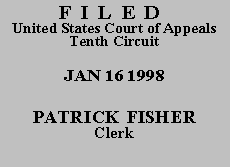

| JANETT M. HALL,
Plaintiff-Appellant, v. KENNETH S. APFEL, Commissioner, Social Security Administration,(*) Defendant-Appellee. |
|
Claimant Janett M. Hall appeals from the district court's judgment affirming the decision of the Commissioner of Social Security denying her application for disability benefits under the Social Security Act. After her application was denied administratively, both initially and upon reconsideration, claimant requested a hearing before an administrative law judge (ALJ). The hearing was held on August 22, 1994. The ALJ concluded that claimant was not disabled under the Social Security Act. On January 5, 1996, the Appeals Council denied claimant's request for review, making the ALJ's decision final for purposes of appeal. See Williams v. Bowen, 844 F.2d 748, 749 (10th Cir. 1988).
Our jurisdiction over this appeal arises from 42 U.S.C. § 405(g). We review the agency's decision to determine whether the factual findings are supported by substantial evidence, viewing the record as a whole, and whether the correct legal standards were applied. See Castellano v. Secretary of Health & Human Servs., 26 F.3d 1027, 1028 (10th Cir. 1994). The agency uses a five-step process to determine the existence of a disability. See, e.g., 20 C.F.R. § 404.1520; Williams, 844 F.2d at 750-52 (discussing five steps in detail). If a claimant is determined to be disabled or not disabled at any step, the evaluation process ends there. See Sorenson v. Bowen, 888 F.2d 706, 710 (10th Cir. 1989). Here, the ALJ found, at the second step of this process, that claimant did not have severe impairments at the time her eligibility for disability benefits expired such that she could be considered disabled. See Potter v. Secretary of Health & Human Servs., 905 F.2d 1346, 1347 (10th Cir. 1990). Claimant bears the burden of proof at step two to demonstrate an impairment or combination of impairments that significantly limits her ability to perform basic work functions. See 20 C.F.R. § 404.1520(c); Hawkins v. Chater, 113 F.3d 1162, 1169 (10th Cir. 1997).
On appeal, claimant raises two arguments. First, she contends that the ALJ wrongly discredited her complaints of pain and chronic fatigue because they were "not confirmed by medical evidence." Appellant's Br. at 14. She argues that she has established the required nexus between her medical condition and her alleged non-exertional impairments, requiring an assessment pursuant to Luna v. Bowen, 834 F.2d 161 (10th Cir. 1987). Our review of the agency's decision indicates that the ALJ did not simply reject these complaints because of a lack of medical evidence. Rather, he noted that, during the three years prior to the expiration of claimant's eligibility for Social Security benefits on December 31, 1988, claimant had sought medical treatment only rarely and that her complaints were unrelated to her current allegations of disability. Appellant's App., Vol. II, at 18-19. Claimant's statements to her physicians are evidence to be considered as a factor in determining the credibility of her complaints, see SSR 96-7p, 1996 WL 374186, at *4. Further, we agree with appellee that the ALJ could rely on the absence of any complaints implicating the non-exertional impairments she now claims, cf. Luna, 834 F.2d at 165-66 (noting court's reliance on claimants' attempts to find relief for pain and regular contact with a physician).
Claimant also contends that the ALJ erred by failing to more fully develop the record with regard to a 1994 diagnosis of connective tissue disease, which, she claims, "obviously relates back to the 1980's." Appellant's Br. at 17. However, we agree with the ALJ that none of the record evidence demonstrates the presence of any functional limitations resulting from this condition before claimant's eligibility ceased. Cf. Potter, 905 F.2d at 1348-49 (noting that even where diagnosis is retrospective, relevant inquiry is whether claimant was actually disabled prior to expiration of eligibility). Accordingly, the ALJ was not obliged to obtain a consultative exam on this point. See Hawkins, 113 F.3d at 1167-69.
The judgment of the United States District Court for the Eastern District of Oklahoma is AFFIRMED.
Entered for the Court
Circuit Judge
*. Effective September 29, 1997, Kenneth S. Apfel became the Commissioner for the Social Security Administration. Pursuant to Fed. R. App. P. 43(c), Mr. Apfel is substituted for Shirley S. Chater, former Commissioner of Social Security, as the defendant in this action.
**. This order and judgment is not binding precedent, except under the doctrines of law of the case, res judicata, and collateral estoppel. The court generally disfavors the citation of orders and judgments; nevertheless, an order and judgment may be cited under the terms and conditions of 10th Cir. R. 36.3.